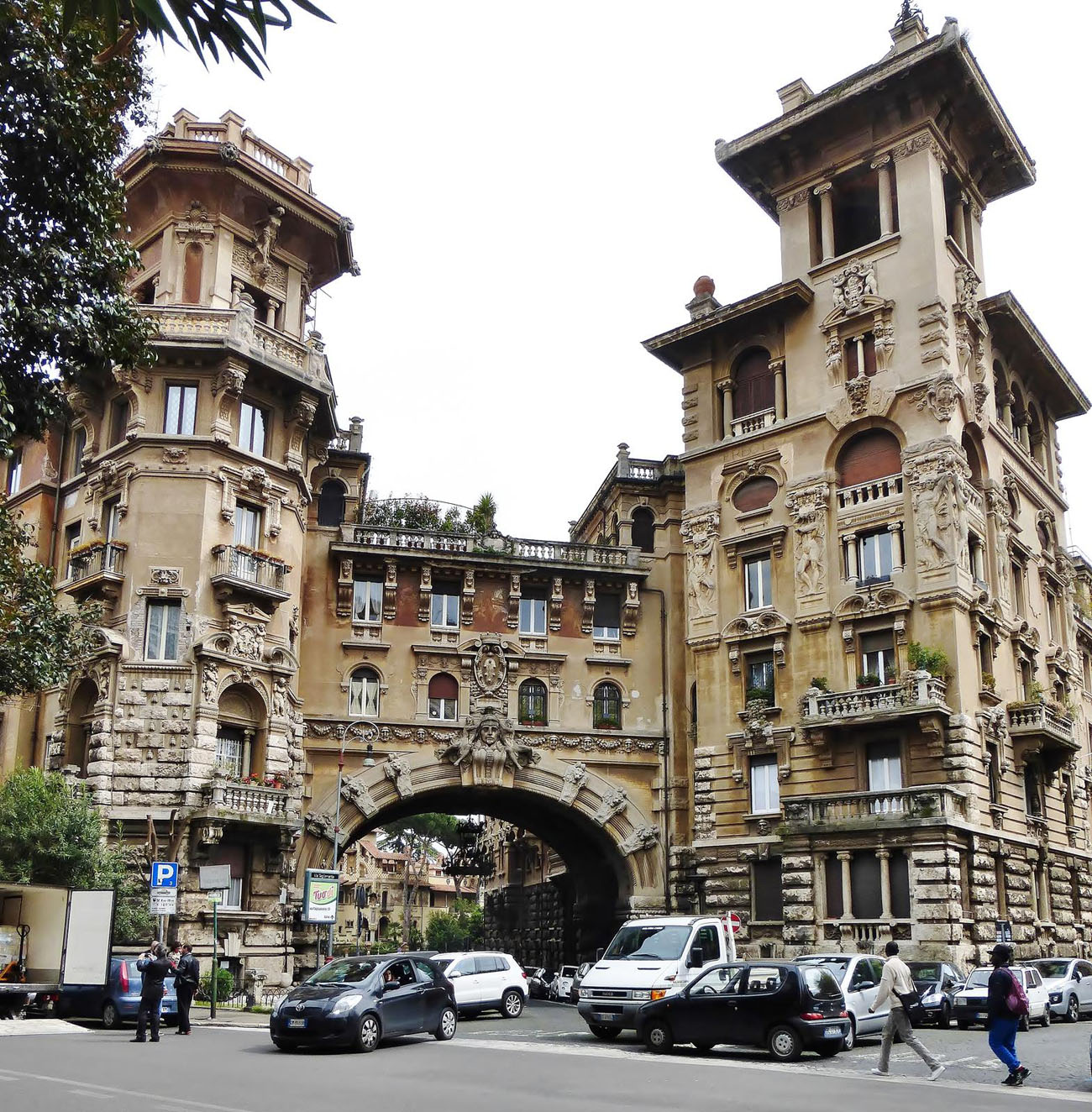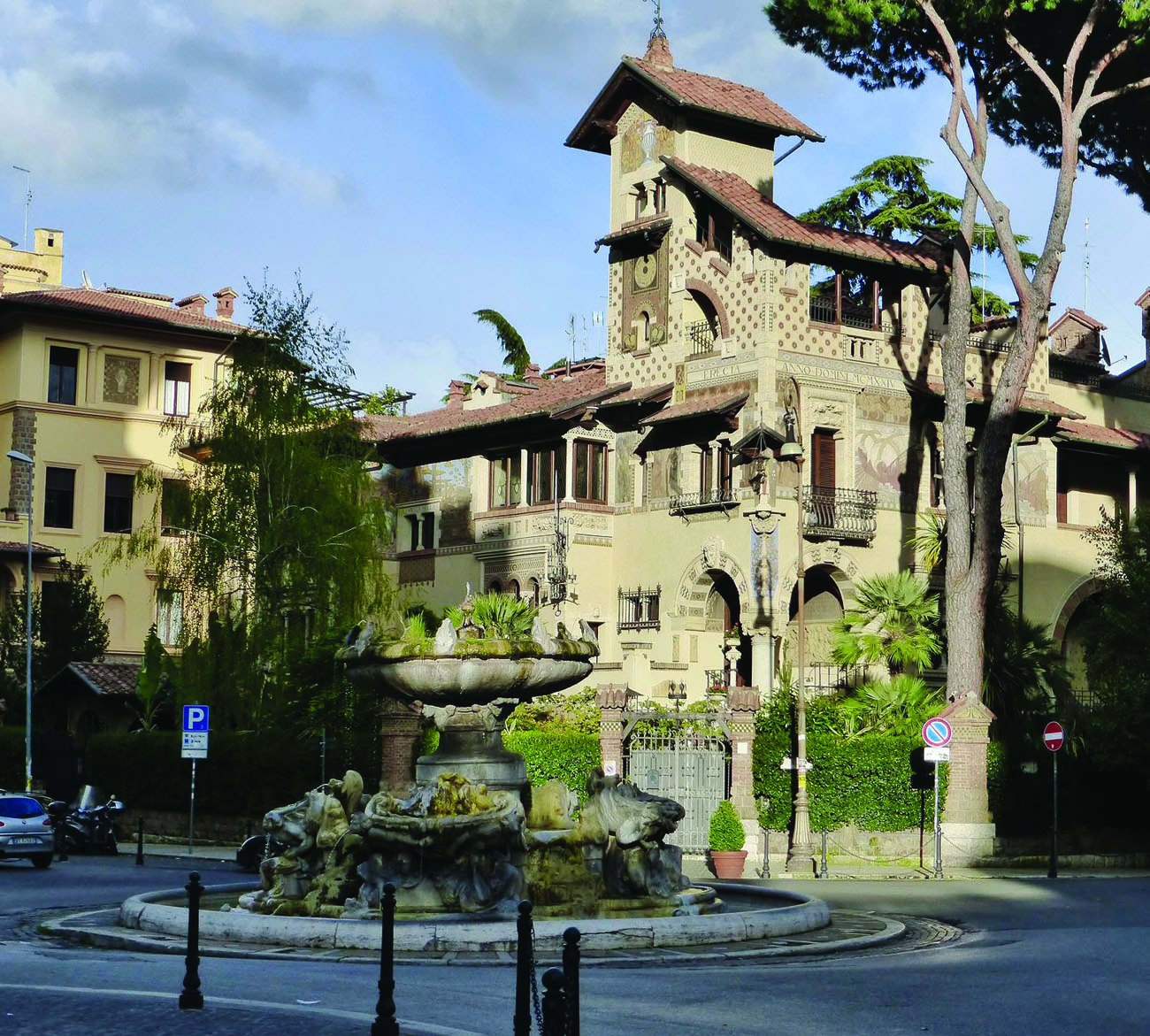Serious books on the architecture of Rome seldom mention Coppedè’s Quarter. If you enjoy it, you are indulging in a guilty pleasure!
 When Gino Coppedè was commissioned to design a residential complex in the Parioli section of Rome, he knew he needed a unifying fountain. Since the time of Marcus Agrippa, who established hundreds of fountains in the city, no self-respecting neighbourhood could be without one. So, in Piazza Mincio, the heart of Coppedè’s complex, he created the Fontana delle Rane, the fountain of the frogs. Piazza Mincio is actually just a traffic roundabout, with the fountain at its centre. It takes some quickness and daring to dodge the shiny sedans in the circle – this is a posh neighbourhood, housing several embassies, so the vehicle bearing down on you may be driven by someone with diplomatic immunity. But with luck you can get close enough to admire the whimsical little frogs lining the rim of the upper basin, and the larger frogs in the Baroque shells of the lower. You might think the fountain is from the era of Bernini, but the whole complex was created between 1919 and 1927.
When Gino Coppedè was commissioned to design a residential complex in the Parioli section of Rome, he knew he needed a unifying fountain. Since the time of Marcus Agrippa, who established hundreds of fountains in the city, no self-respecting neighbourhood could be without one. So, in Piazza Mincio, the heart of Coppedè’s complex, he created the Fontana delle Rane, the fountain of the frogs. Piazza Mincio is actually just a traffic roundabout, with the fountain at its centre. It takes some quickness and daring to dodge the shiny sedans in the circle – this is a posh neighbourhood, housing several embassies, so the vehicle bearing down on you may be driven by someone with diplomatic immunity. But with luck you can get close enough to admire the whimsical little frogs lining the rim of the upper basin, and the larger frogs in the Baroque shells of the lower. You might think the fountain is from the era of Bernini, but the whole complex was created between 1919 and 1927.
Coppedè’s commission gave him considerable freedom, and he exploited it with gusto. He created palazzi and villas in a bewildering (and rather bewitching) multitude of styles, about 40 structures in all, around the area of Via Tagliamento and Via Dora. He loved ornamentation, and applied it exuberantly. Under a grand entrance arch, decorated with a huge, forbidding mascherone (sculpted face), and a frieze of garlands and Greek masks, hangs an enormous art-deco wrought-iron chandelier. On either side of the arch are towers of the Palazzo degli Ambasciatori, a large apartment block. The façades are encrusted with mannerist nudes, Romanesque and Renaissance loggias, Baroque balcony corbels, and medieval grotesques – all in travertine or marble.
Even more striking is the Villino delle Fate, the House of the Fairies, which is framed by the arch as you look past the fountain. I can’t begin to tell you the derivation of its form, but it really doesn’t matter. There are loggias, brick arches, half-arches, columns with capitals of every classical order and more. There are tiles, statues, a relief of the Capitoline wolf, art-nouveau wrought-iron balconies, a working sundial, and walls painted with images of Venetian galleys, Florentine cityscapes, Dante and Boccaccio.
Across Piazza Mincio is the Palazzina del Ragno, the Palace of the Spider, surprisingly harmonious in design, although constructed of brick, wood, stucco, marble, and stone. There is a stern marble mask of a king over the main entrance, as well as a menacing golden spider waiting within its web to greet you.
A walk through the neighbourhood, now known as Quartiere Coppedè, can entertain and delight for hours, but Coppedè’s imaginative vision was not well appreciated by contemporary architects in Italy. The Fascist dream of reviving the glory of Imperial Rome required an austere magnificence, and a lighthearted composite salute to Italy’s architectural heritage was not useful. Even today, serious books on the architecture of Rome seldom mention Coppedè’s Quarter. So beware – if you visit and enjoy it, you are indulging in a guilty pleasure!
